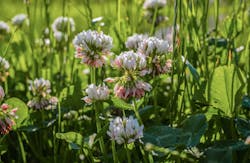Fluorine is a fairly common element in Earth's crust and concentrated in materials like phosphate rocks, which are the main ingredient in many phosphorus fertilizers. In areas where phosphorus fertilizers are applied regularly, fluorine can accumulate in soils and can become a soil contaminant. High levels of fluorine in the soil can even hurt plants and affect microbes and other organisms.
To better understand tolerable levels of fluorine, researchers in New Zealand recently conducted a study to explore whether the element's levels in the country's soil are high enough to harm a specific microbe called Rhizobium. "No one has investigated the potential impact of fluorine on Rhizobia," says Christopher Anderson, a researcher at Massey University in New Zealand.
Rhizobium bacteria live in the root nodules of legume plants like beans and lentils and are nitrogen-fixing—they can convert atmospheric nitrogen into a form plants can use. Nitrogen fixation by Rhizobia means farmers need less nitrogen fertilizer, reducing costs for the farmer and nitrogen runoff in surface water. If soil fluorine levels become high enough to harm Rhizobia it could impact not only the legume crops the bacteria supports, but have rippling effects in water quality and environmental health. Pastures for grazing livestock often contain clover, another legume that hosts Rhizobia in its root nodules. Excess fluorine could also impact the livestock that eats the clover.
In the study, published in April in the Journal of Environmental Quality, Anderson and colleagues found that high levels of fluorine are toxic to Rhizobia and white clover. In their laboratory studies, fluorine levels above 100 mg per liter hampered the growth of Rhizobia and high concentrations also led to changes in the shape and metabolic activity of the bacterial. The clover was also impacted; at concentrations above 100 mg per liter, white clover seedlings did not survive.
However, they also found that the concentration at which fluorine is toxic is much higher than the concentrations they found in New Zealand's soils. "This means that there is no problem, right now, of fluorine levels in soil affecting Rhizobia in New Zealand's soils," says Anderson. The finding provides confidence to agencies in New Zealand tasked with ensuring a sustainable farming system. "Without our research, they would still be in the dark," says Anderson.
Rhizobia and white clover are key parts of New Zealand's way of animal husbandry. "In New Zealand, we are fortunate that we can grow grass year-round," says Anderson. "Our livestock are kept on pasture all year."
The Rhizobium bacteria in the clover fix nitrogen from the atmosphere, and when the clover plants die and break down in the soil, the fixed nitrogen becomes available to other plants. "So," says Anderson, "we don't need to apply as much synthetic nitrogen fertilizers, such as urea, to our pastures with clover."
Farmers do need to apply other fertilizers to New Zealand's pastures, however, including phosphorus fertilizers. That's where concerns about fluorine and fluorine accumulation come in.
"But in some cases, biological systems are very tolerant of contaminants," says Anderson.
Anderson aims to determine fluorine levels at which it is toxic to animals. "In particular we would like to look at earthworms," says Anderson. "Earthworms are very useful ecological indicators."
Researchers also want to look at grazing animals, which can eat a considerable amount of soil. When animals ingest too much fluorine, they can develop fluorosis. That can cause bone, teeth, and kidney problems.
"We have to make sure the science is looking after all aspects of the pastoral system—soil, microorganisms, plants, and animals," says Anderson.






